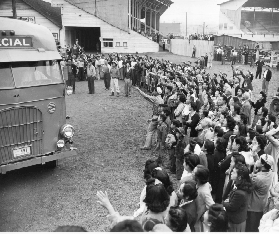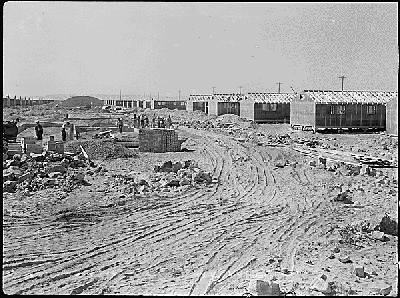Move to Minidoka
Rumors about the ultimate destination for the inmates of Camp Harmony began almost immediately. The camp newsletter regularly featured stories about Tule Lake and an advance crew from Puyallup did leave for California. Contradictory announcements from the Army helped fuel the rumors but by the middle of July it was evident that Tule Lake was reaching capacity. But even as of July 18, 1942 the camp newsletter was reporting that "An army press release, dated June 4, had stated that Camp Harmony residents were slated for Tule Lake. However, no further orders on relocation have been received, the WCCA office indicated. No credence was placed in reports that Idaho would be the ultimate relocation center."
By early August an advance crew of Camp Harmony residents were sent to Minidoka in southeastern Idaho. Within a month the camp had been emptied and Seattle's Japanese Americans found themselves in yet another hastily constructed prison camp.
|
Relocation Communities for Wartime Evacuees. Washington, D.C.: War Relocation Authority, September 1942, p. 9. James Y. Sakamoto papers, Box 10. UW Libraries Special Collections. |
Minidoka Location: Jerome County, Idaho Second in gross acreage only to Colorado River, The Minidoka Relocation Area in south-central Idaho on the Gooding Division of the Minidoka Reclamation Project presents a peculiar problem of land development. Because the area is broken up by huge outcroppings of lava, only 25 per cent of the broad acreage is even potentially suited to agriculture. Yet the soil between the outcroppings is fertile and needs only irrigation water to yield abundant crops. Plans for development of this public land area were planned out by the Bureau of Reclamation and will be carried forward by the evacuees. By next year several thousand acres would be under cultivation and producing most of the food needed for the evacuee community and perhaps a surplus for other relocation centers. Major crops will be potatoes, beans, and onions. Hay crops such as alfalfa and clover will also be grown, along with barley and oats. After the war the land will revert to the Bureau of Reclamation and will be available for settlement. Lying at an elevation of 3800 feet, the Minidoka area has temperatures ranging from 30 degrees below zero to 104 above. The average annual rainfall is 10 inches and the growing season averages around 138 days. |
|
"Japanese at Puyallup to Go to Idaho." Seattle Times, August 5, 1942, pg. 1. |
The 7,200 evacuated Japanese who have been quartered at Camp Harmony at the Western Washington Fair Grounds and the area immediately adjacent to the grounds in Puyallup since April, will be transferred to a permanent relocation center in Idaho, beginning next Sunday. The announcement was made today by Col. Karl R. Bendetson, assistant chief of staff, Civil Affairs Division of the Western Defense Command and the Fourth Army. Known as the Minidoka Relocation Center, the Idaho camp has been under construction for some months near Eden, Jerome County, about 15 miles southeast of Twin Falls and 150 miles southeast of Boise. |
|
"PUYALLUP MOVES." Pacific Cable, August 12, 1942, pg. 1. |
The New Relocation Centers The 7,000 evacuees now at Puyallup will be transferred to the Minidoka Relocation Center near Eden, Idaho before the end of this month. 200 left August 9 to assist in the preparations of the camp. The first regular group leaves from Area D this Saturday August 15. Social calls and business visits must be made before the following days at Puyallup. Area D .......... August 13 |
|
Seattle Post-Intelligencer Collection, PI-28080 Museum of History and Industry, Seattle Washington. |
|
|
Letter from Fred to Charles (Ted) Takahashi describing conditions at Minidoka dated August 24, 1942. Charles Theodore Takahashi Papers. Box 5. UW Libraries Special Collections. |
The mosquitoes aren't quite so thick lately, it's probably because they have more people to pick on. As far as making preparations in furnishing your future "apartments" is concerned I really think it's best you do it after you get here except that you might get some sort of a heavy drape for the closet. It's open clear to the ceiling and six feet wide. There is plenty of scrap lumber to make tables, shelves etc. and we've swiped (that's not a very good word) quite a bit of it and have started making a few pieces of ruff [sic] furniture. |
|
Letter from Kenji Okuda to Norio Higano dated August 27, 1942. Higano Family Papers, Acc. 2870, Box 1, folders 9-11. UW Libraries Special Collections. |
The camp is still very far from completed. They had to interrupt movement for a week because of lack of housing facilities - in fact the last group of 500 which left had to sleep in mess halls, laundry rooms, and any available bed space. |
|
Photograph No. 538296. "Eden, Idaho. A panorama view of the Minidoka War Relocation Authority center." August 18, 1942. National Archives and Record Administration; War Relocation Authority, Record Group 210. National Archives at College Park, College Park, MD. |
|
|
Minidoka Project Information Bulletin No. 5 dated August 19, 1942 Hiroyuki Ichihara Papers. Reel 2. UW Libraries Special Collections. |
New arrivals at the Minidoka War Relocation Authority Project will first register and be assigned to apartments which have been constructed for use as your homes. Obviously construction is not complete. REGISTRATIONRegistration is in this room. As soon as the head of the family registers, the family will go to the laundry building immediately back of this building where you will see the physician, then receive your apartment assignment. A guide will take you to your apartment and the head of the family should remain at the apartment to receive and sign for your beds, bedding and baggage. ASSIGNMENT OF APARTMENTSApartments are of three sizes and a family will be assigned on the basis of the number in a family. Wherever possible family groups or relatives will be assigned to apartments near to each other. Where possible reassignments to other apartments will be made later to locate persons near their place of employment. Moving from the apartment to which you have been assigned to another must NOT be done without approval of the Housing Superintendent. |

